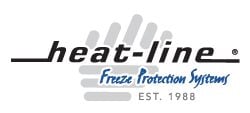Prevent High-Efficiency Furnace Condensate Lines From Freezing
An important but often overlooked characteristic of high-efficiency furnaces is the risk of frozen condensate lines. If a condensate line freezes, a furnace will eventually shut down on limit and become unable to function causing freezing conditions in the building. Freeze protection of condensate pipes is a vital consideration when planning, installing or servicing an HVAC system.
A Safe and Reliable Freeze Protection Solution
Constant wattage, hardware store heat tape also known as heat wrap for pipes, is often improperly used to protect condensate from freezing causing fire hazard danger. Heat-Line specializes in freeze protection systems that have the capability to easily, efficiently and safely freeze-protect condensate lines in both new and existing HVAC systems. Heat-Line heating cable systems can be applied either internally or externally on all types and sizes of condensate lines. The systems are wet location approved which is favourable to installations where drip pans are in close proximity to the condensate line and the liquid could come into contact with the heating cable system. Unlike hardware store heat tape or heat wrap for pipes, Heat-Line self-regulating heating cable systems will not overheat, even if the pipe is dry, and are safe and certified for metal or non-metal pipe. Heat-Line heating cables are easy to install, safe to operate, come in complete systems and can be ordered in custom lengths.


Stop Frozen Condensate Lines Internally
Many times an internal application is preferred for an efficient and elegant solution, but is often considered impossible due to the carbonic acid present in condensate lines. A unique solution Heat-Line provides for this application is the EXT-T series self-regulating heating cable or the Retro-Line Mini self-regulating heating cable system. Both EXT-T and Retro-Line Mini heating cables are manufactured using fluoropolymer outer jackets and unique polymers for the proprietary end seal, both of which are impervious to damage from organic and inorganic chemicals. As a result, EXT-T and Retro-Line Mini are suitable for freeze-protecting in this environment and therefore can safely be installed inside condensate lines. Below are the two internal methods for freeze protecting a condensate line.
1. Install EXT-T inside the condensate drain pipe.
EXT-T presents a straightforward method to freeze protect inside the drain pipe when there is access to an open end and a watertight entry seal is not required. The heating cable can simply be ordered to the length required, pushed in the pipe (minimum pipe size 3/4 inch ID) and plugged into an outlet nearby. Such a connection may be suitable for a condensate drain air gap depending on the plumbing setup. If such a connection is not already present, or is not accessible, an air gap or daylight opening may be introduced provided that the plumbing setup allows for it. This first internal method of installing EXT-T may be preferred over the second method below due to it’s simplicity. No fittings are required with the heating cable system and the accessible entry may already be present in the plumbing setup.


2. Install Retro-Line Mini inside the condensate drain pipe.
When a watertight entry seal is required, Retro-Line Mini can be used to internally freeze protect a condensate drain line. Retro-Line Mini is supplied with the necessary plumbing fittings to achieve a watertight entry where the heating cable is installed inside the pipe. The system can be installed inside pipes as small as 1/2 inch (with a minimum inside diameter of 0.485 inch or greater). Given that condensate lines often have small diameters, the Retro-Line Mini is uniquely suited for this application.


Stop Frozen Condensate Lines Externally
For condensate lines where an internal installation is not possible or is not preferred, the Paladin self-regulating heating cable system by Heat-Line can instead be used externally to freeze protect the line. In the video below we look at how to prevent a boiler condensate line from freezing using our Paladin for Pipe externally applied heating cable system.
This system can also be used with insulation to increase performance and efficiency. Heat-Line systems do not require high limit control devices making them ideal for these applications and are a certified reliable solution to prevent frozen condensate lines, mitigating the risk of a high-efficiency furnace failure. Always check with local building codes to be sure of application conformity.


Leeching Pit Freeze Protection
Further, if the drip pan itself or exterior leeching pit at the end of a condensate line may also require freeze protection, they can be protected with the same heating cable system.


